Taxation Law Assignment: Income, Residency, and Deductions Analysis
VerifiedAdded on 2020/03/01
|9
|3116
|14
Homework Assignment
AI Summary
This document presents a comprehensive solution to a Taxation Law assignment, addressing various aspects of Australian taxation. Part A explores the sources of tax law, including the Constitution, legislation, and court decisions, alongside key concepts like Medicare levy, deductible expenses, and methods for valuing trading stock. Part B delves into deductions for tax-related expenses and the deductibility of income tax payments. Part C focuses on determining tax residency based on the resides test and 183-day test, providing analysis for a specific case. Part D calculates assessable income, considering income from employment, tips, gifts, and fringe benefits. Finally, Part E discusses the deductibility of house expenses when used for business purposes. The assignment demonstrates the application of relevant tax laws and rulings to practical scenarios.
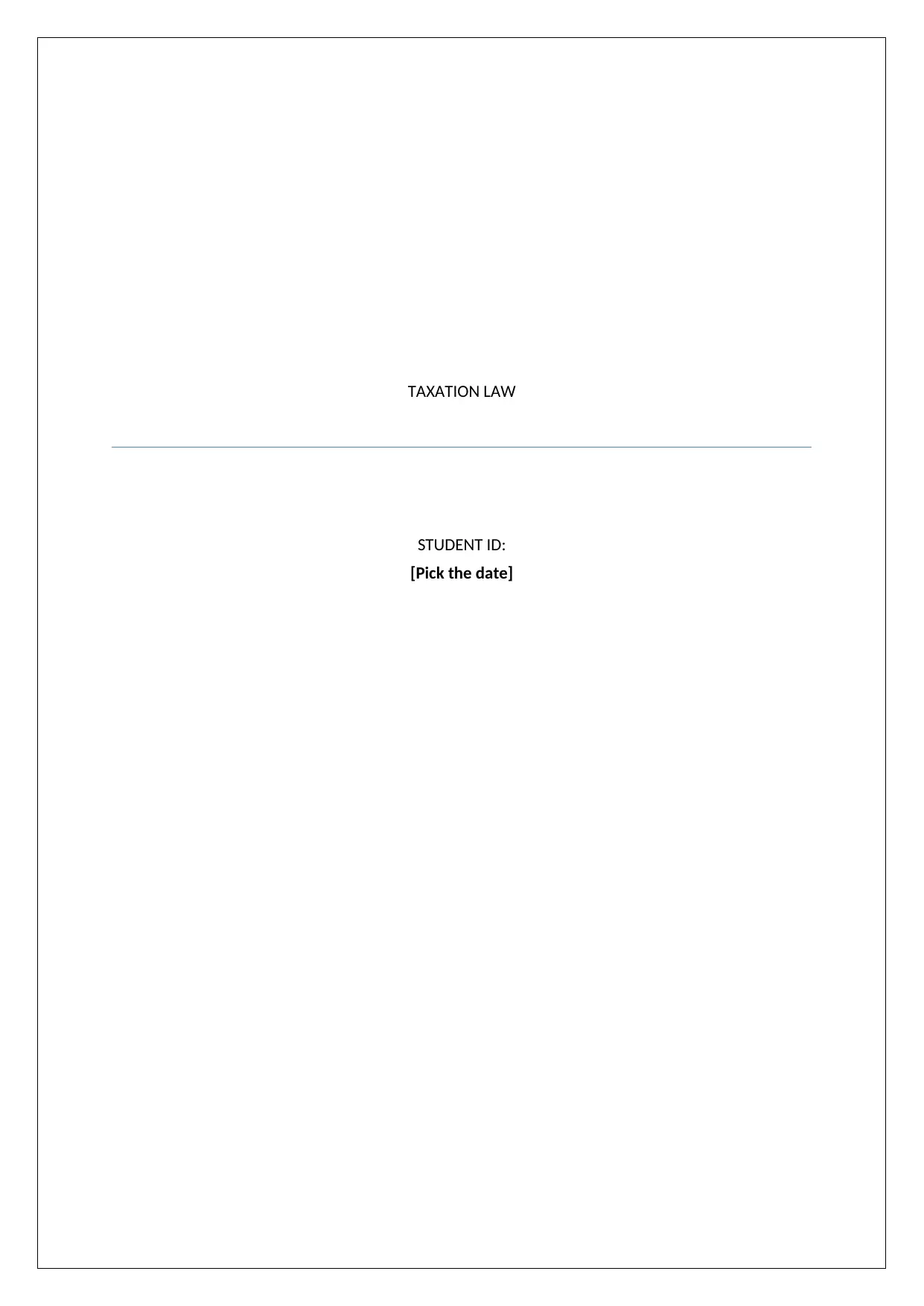
TAXATION LAW
STUDENT ID:
[Pick the date]
STUDENT ID:
[Pick the date]
Paraphrase This Document
Need a fresh take? Get an instant paraphrase of this document with our AI Paraphraser
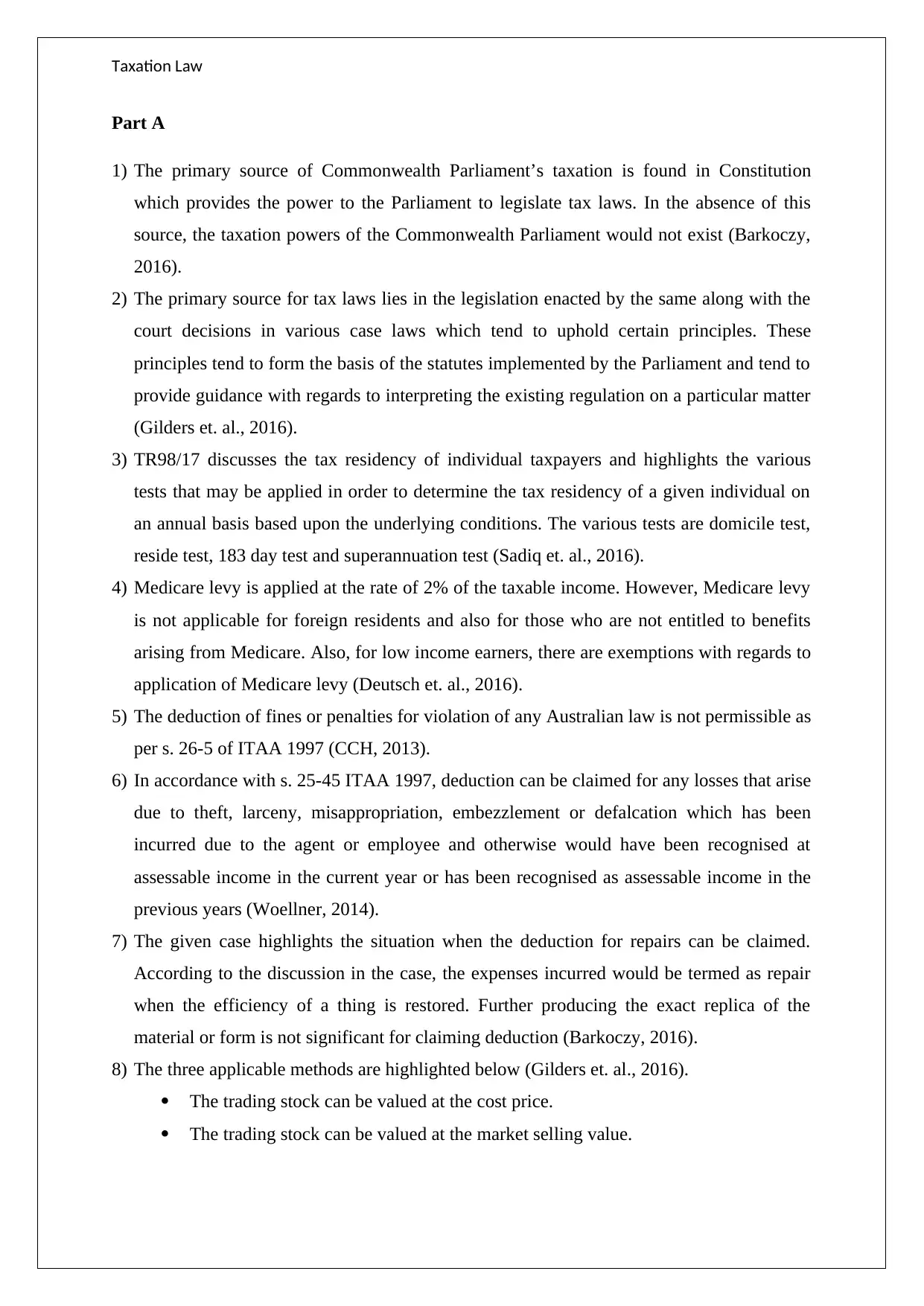
Taxation Law
Part A
1) The primary source of Commonwealth Parliament’s taxation is found in Constitution
which provides the power to the Parliament to legislate tax laws. In the absence of this
source, the taxation powers of the Commonwealth Parliament would not exist (Barkoczy,
2016).
2) The primary source for tax laws lies in the legislation enacted by the same along with the
court decisions in various case laws which tend to uphold certain principles. These
principles tend to form the basis of the statutes implemented by the Parliament and tend to
provide guidance with regards to interpreting the existing regulation on a particular matter
(Gilders et. al., 2016).
3) TR98/17 discusses the tax residency of individual taxpayers and highlights the various
tests that may be applied in order to determine the tax residency of a given individual on
an annual basis based upon the underlying conditions. The various tests are domicile test,
reside test, 183 day test and superannuation test (Sadiq et. al., 2016).
4) Medicare levy is applied at the rate of 2% of the taxable income. However, Medicare levy
is not applicable for foreign residents and also for those who are not entitled to benefits
arising from Medicare. Also, for low income earners, there are exemptions with regards to
application of Medicare levy (Deutsch et. al., 2016).
5) The deduction of fines or penalties for violation of any Australian law is not permissible as
per s. 26-5 of ITAA 1997 (CCH, 2013).
6) In accordance with s. 25-45 ITAA 1997, deduction can be claimed for any losses that arise
due to theft, larceny, misappropriation, embezzlement or defalcation which has been
incurred due to the agent or employee and otherwise would have been recognised at
assessable income in the current year or has been recognised as assessable income in the
previous years (Woellner, 2014).
7) The given case highlights the situation when the deduction for repairs can be claimed.
According to the discussion in the case, the expenses incurred would be termed as repair
when the efficiency of a thing is restored. Further producing the exact replica of the
material or form is not significant for claiming deduction (Barkoczy, 2016).
8) The three applicable methods are highlighted below (Gilders et. al., 2016).
The trading stock can be valued at the cost price.
The trading stock can be valued at the market selling value.
Part A
1) The primary source of Commonwealth Parliament’s taxation is found in Constitution
which provides the power to the Parliament to legislate tax laws. In the absence of this
source, the taxation powers of the Commonwealth Parliament would not exist (Barkoczy,
2016).
2) The primary source for tax laws lies in the legislation enacted by the same along with the
court decisions in various case laws which tend to uphold certain principles. These
principles tend to form the basis of the statutes implemented by the Parliament and tend to
provide guidance with regards to interpreting the existing regulation on a particular matter
(Gilders et. al., 2016).
3) TR98/17 discusses the tax residency of individual taxpayers and highlights the various
tests that may be applied in order to determine the tax residency of a given individual on
an annual basis based upon the underlying conditions. The various tests are domicile test,
reside test, 183 day test and superannuation test (Sadiq et. al., 2016).
4) Medicare levy is applied at the rate of 2% of the taxable income. However, Medicare levy
is not applicable for foreign residents and also for those who are not entitled to benefits
arising from Medicare. Also, for low income earners, there are exemptions with regards to
application of Medicare levy (Deutsch et. al., 2016).
5) The deduction of fines or penalties for violation of any Australian law is not permissible as
per s. 26-5 of ITAA 1997 (CCH, 2013).
6) In accordance with s. 25-45 ITAA 1997, deduction can be claimed for any losses that arise
due to theft, larceny, misappropriation, embezzlement or defalcation which has been
incurred due to the agent or employee and otherwise would have been recognised at
assessable income in the current year or has been recognised as assessable income in the
previous years (Woellner, 2014).
7) The given case highlights the situation when the deduction for repairs can be claimed.
According to the discussion in the case, the expenses incurred would be termed as repair
when the efficiency of a thing is restored. Further producing the exact replica of the
material or form is not significant for claiming deduction (Barkoczy, 2016).
8) The three applicable methods are highlighted below (Gilders et. al., 2016).
The trading stock can be valued at the cost price.
The trading stock can be valued at the market selling value.
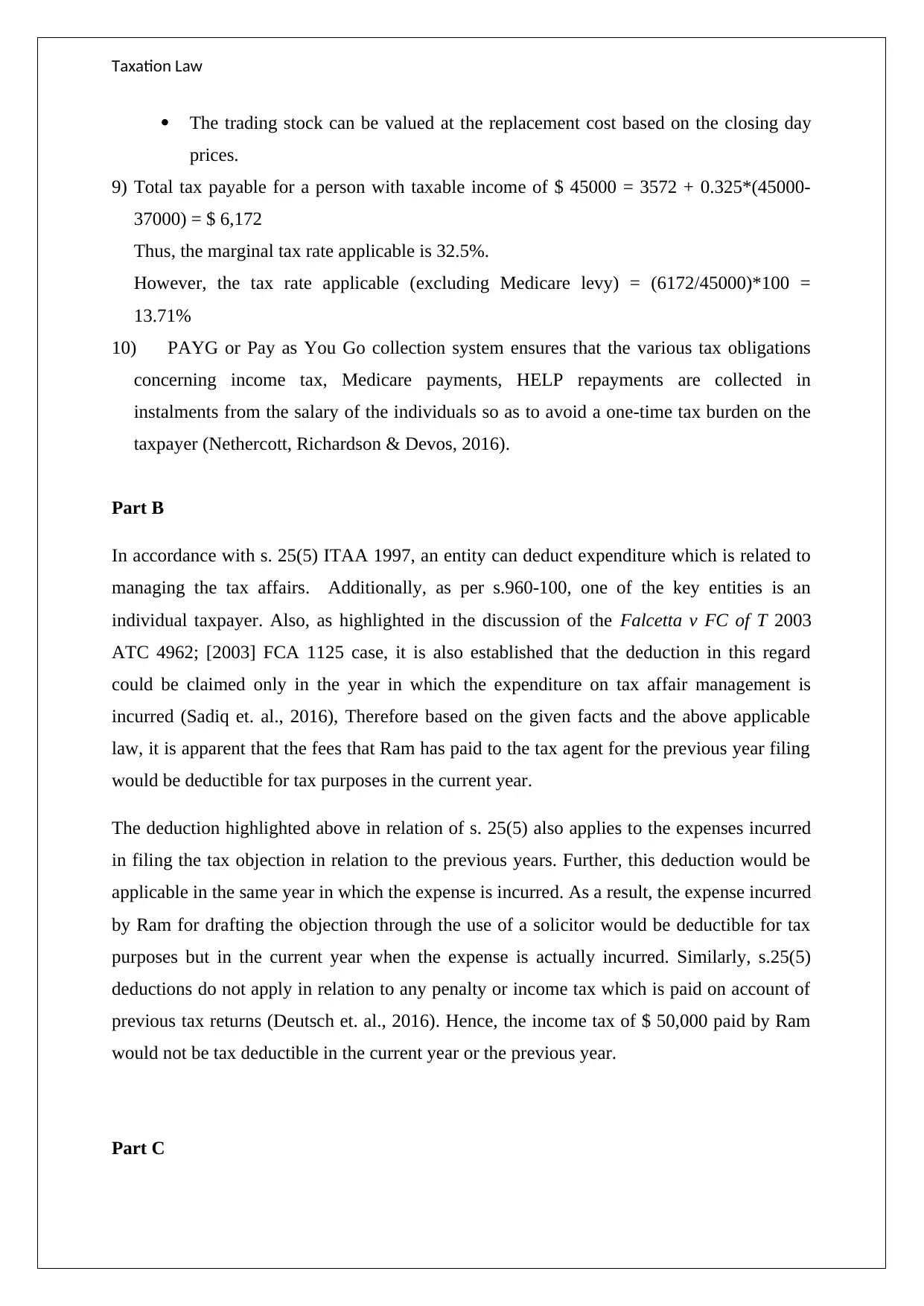
Taxation Law
The trading stock can be valued at the replacement cost based on the closing day
prices.
9) Total tax payable for a person with taxable income of $ 45000 = 3572 + 0.325*(45000-
37000) = $ 6,172
Thus, the marginal tax rate applicable is 32.5%.
However, the tax rate applicable (excluding Medicare levy) = (6172/45000)*100 =
13.71%
10) PAYG or Pay as You Go collection system ensures that the various tax obligations
concerning income tax, Medicare payments, HELP repayments are collected in
instalments from the salary of the individuals so as to avoid a one-time tax burden on the
taxpayer (Nethercott, Richardson & Devos, 2016).
Part B
In accordance with s. 25(5) ITAA 1997, an entity can deduct expenditure which is related to
managing the tax affairs. Additionally, as per s.960-100, one of the key entities is an
individual taxpayer. Also, as highlighted in the discussion of the Falcetta v FC of T 2003
ATC 4962; [2003] FCA 1125 case, it is also established that the deduction in this regard
could be claimed only in the year in which the expenditure on tax affair management is
incurred (Sadiq et. al., 2016), Therefore based on the given facts and the above applicable
law, it is apparent that the fees that Ram has paid to the tax agent for the previous year filing
would be deductible for tax purposes in the current year.
The deduction highlighted above in relation of s. 25(5) also applies to the expenses incurred
in filing the tax objection in relation to the previous years. Further, this deduction would be
applicable in the same year in which the expense is incurred. As a result, the expense incurred
by Ram for drafting the objection through the use of a solicitor would be deductible for tax
purposes but in the current year when the expense is actually incurred. Similarly, s.25(5)
deductions do not apply in relation to any penalty or income tax which is paid on account of
previous tax returns (Deutsch et. al., 2016). Hence, the income tax of $ 50,000 paid by Ram
would not be tax deductible in the current year or the previous year.
Part C
The trading stock can be valued at the replacement cost based on the closing day
prices.
9) Total tax payable for a person with taxable income of $ 45000 = 3572 + 0.325*(45000-
37000) = $ 6,172
Thus, the marginal tax rate applicable is 32.5%.
However, the tax rate applicable (excluding Medicare levy) = (6172/45000)*100 =
13.71%
10) PAYG or Pay as You Go collection system ensures that the various tax obligations
concerning income tax, Medicare payments, HELP repayments are collected in
instalments from the salary of the individuals so as to avoid a one-time tax burden on the
taxpayer (Nethercott, Richardson & Devos, 2016).
Part B
In accordance with s. 25(5) ITAA 1997, an entity can deduct expenditure which is related to
managing the tax affairs. Additionally, as per s.960-100, one of the key entities is an
individual taxpayer. Also, as highlighted in the discussion of the Falcetta v FC of T 2003
ATC 4962; [2003] FCA 1125 case, it is also established that the deduction in this regard
could be claimed only in the year in which the expenditure on tax affair management is
incurred (Sadiq et. al., 2016), Therefore based on the given facts and the above applicable
law, it is apparent that the fees that Ram has paid to the tax agent for the previous year filing
would be deductible for tax purposes in the current year.
The deduction highlighted above in relation of s. 25(5) also applies to the expenses incurred
in filing the tax objection in relation to the previous years. Further, this deduction would be
applicable in the same year in which the expense is incurred. As a result, the expense incurred
by Ram for drafting the objection through the use of a solicitor would be deductible for tax
purposes but in the current year when the expense is actually incurred. Similarly, s.25(5)
deductions do not apply in relation to any penalty or income tax which is paid on account of
previous tax returns (Deutsch et. al., 2016). Hence, the income tax of $ 50,000 paid by Ram
would not be tax deductible in the current year or the previous year.
Part C
⊘ This is a preview!⊘
Do you want full access?
Subscribe today to unlock all pages.

Trusted by 1+ million students worldwide
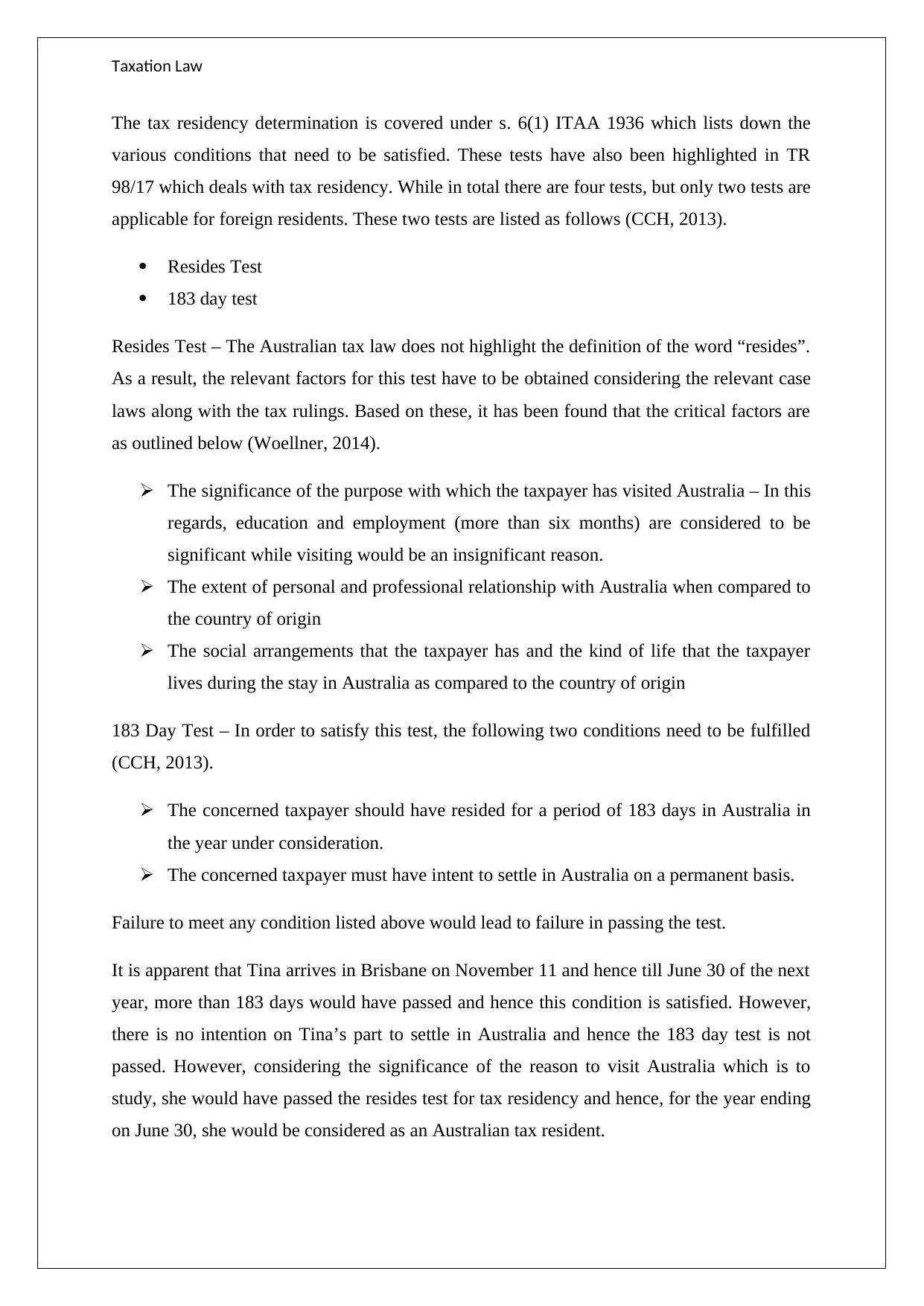
Taxation Law
The tax residency determination is covered under s. 6(1) ITAA 1936 which lists down the
various conditions that need to be satisfied. These tests have also been highlighted in TR
98/17 which deals with tax residency. While in total there are four tests, but only two tests are
applicable for foreign residents. These two tests are listed as follows (CCH, 2013).
Resides Test
183 day test
Resides Test – The Australian tax law does not highlight the definition of the word “resides”.
As a result, the relevant factors for this test have to be obtained considering the relevant case
laws along with the tax rulings. Based on these, it has been found that the critical factors are
as outlined below (Woellner, 2014).
The significance of the purpose with which the taxpayer has visited Australia – In this
regards, education and employment (more than six months) are considered to be
significant while visiting would be an insignificant reason.
The extent of personal and professional relationship with Australia when compared to
the country of origin
The social arrangements that the taxpayer has and the kind of life that the taxpayer
lives during the stay in Australia as compared to the country of origin
183 Day Test – In order to satisfy this test, the following two conditions need to be fulfilled
(CCH, 2013).
The concerned taxpayer should have resided for a period of 183 days in Australia in
the year under consideration.
The concerned taxpayer must have intent to settle in Australia on a permanent basis.
Failure to meet any condition listed above would lead to failure in passing the test.
It is apparent that Tina arrives in Brisbane on November 11 and hence till June 30 of the next
year, more than 183 days would have passed and hence this condition is satisfied. However,
there is no intention on Tina’s part to settle in Australia and hence the 183 day test is not
passed. However, considering the significance of the reason to visit Australia which is to
study, she would have passed the resides test for tax residency and hence, for the year ending
on June 30, she would be considered as an Australian tax resident.
The tax residency determination is covered under s. 6(1) ITAA 1936 which lists down the
various conditions that need to be satisfied. These tests have also been highlighted in TR
98/17 which deals with tax residency. While in total there are four tests, but only two tests are
applicable for foreign residents. These two tests are listed as follows (CCH, 2013).
Resides Test
183 day test
Resides Test – The Australian tax law does not highlight the definition of the word “resides”.
As a result, the relevant factors for this test have to be obtained considering the relevant case
laws along with the tax rulings. Based on these, it has been found that the critical factors are
as outlined below (Woellner, 2014).
The significance of the purpose with which the taxpayer has visited Australia – In this
regards, education and employment (more than six months) are considered to be
significant while visiting would be an insignificant reason.
The extent of personal and professional relationship with Australia when compared to
the country of origin
The social arrangements that the taxpayer has and the kind of life that the taxpayer
lives during the stay in Australia as compared to the country of origin
183 Day Test – In order to satisfy this test, the following two conditions need to be fulfilled
(CCH, 2013).
The concerned taxpayer should have resided for a period of 183 days in Australia in
the year under consideration.
The concerned taxpayer must have intent to settle in Australia on a permanent basis.
Failure to meet any condition listed above would lead to failure in passing the test.
It is apparent that Tina arrives in Brisbane on November 11 and hence till June 30 of the next
year, more than 183 days would have passed and hence this condition is satisfied. However,
there is no intention on Tina’s part to settle in Australia and hence the 183 day test is not
passed. However, considering the significance of the reason to visit Australia which is to
study, she would have passed the resides test for tax residency and hence, for the year ending
on June 30, she would be considered as an Australian tax resident.
Paraphrase This Document
Need a fresh take? Get an instant paraphrase of this document with our AI Paraphraser
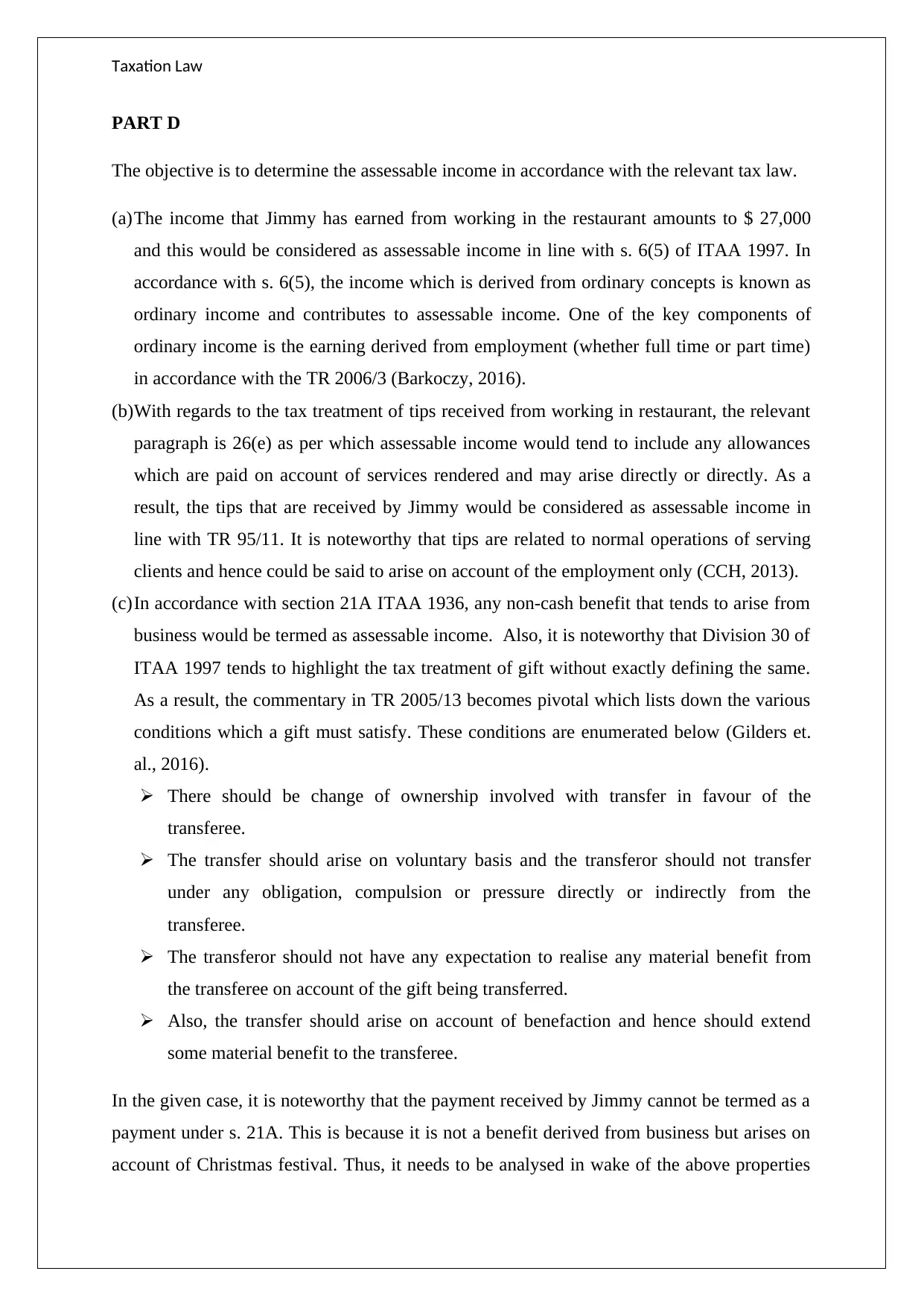
Taxation Law
PART D
The objective is to determine the assessable income in accordance with the relevant tax law.
(a)The income that Jimmy has earned from working in the restaurant amounts to $ 27,000
and this would be considered as assessable income in line with s. 6(5) of ITAA 1997. In
accordance with s. 6(5), the income which is derived from ordinary concepts is known as
ordinary income and contributes to assessable income. One of the key components of
ordinary income is the earning derived from employment (whether full time or part time)
in accordance with the TR 2006/3 (Barkoczy, 2016).
(b)With regards to the tax treatment of tips received from working in restaurant, the relevant
paragraph is 26(e) as per which assessable income would tend to include any allowances
which are paid on account of services rendered and may arise directly or directly. As a
result, the tips that are received by Jimmy would be considered as assessable income in
line with TR 95/11. It is noteworthy that tips are related to normal operations of serving
clients and hence could be said to arise on account of the employment only (CCH, 2013).
(c)In accordance with section 21A ITAA 1936, any non-cash benefit that tends to arise from
business would be termed as assessable income. Also, it is noteworthy that Division 30 of
ITAA 1997 tends to highlight the tax treatment of gift without exactly defining the same.
As a result, the commentary in TR 2005/13 becomes pivotal which lists down the various
conditions which a gift must satisfy. These conditions are enumerated below (Gilders et.
al., 2016).
There should be change of ownership involved with transfer in favour of the
transferee.
The transfer should arise on voluntary basis and the transferor should not transfer
under any obligation, compulsion or pressure directly or indirectly from the
transferee.
The transferor should not have any expectation to realise any material benefit from
the transferee on account of the gift being transferred.
Also, the transfer should arise on account of benefaction and hence should extend
some material benefit to the transferee.
In the given case, it is noteworthy that the payment received by Jimmy cannot be termed as a
payment under s. 21A. This is because it is not a benefit derived from business but arises on
account of Christmas festival. Thus, it needs to be analysed in wake of the above properties
PART D
The objective is to determine the assessable income in accordance with the relevant tax law.
(a)The income that Jimmy has earned from working in the restaurant amounts to $ 27,000
and this would be considered as assessable income in line with s. 6(5) of ITAA 1997. In
accordance with s. 6(5), the income which is derived from ordinary concepts is known as
ordinary income and contributes to assessable income. One of the key components of
ordinary income is the earning derived from employment (whether full time or part time)
in accordance with the TR 2006/3 (Barkoczy, 2016).
(b)With regards to the tax treatment of tips received from working in restaurant, the relevant
paragraph is 26(e) as per which assessable income would tend to include any allowances
which are paid on account of services rendered and may arise directly or directly. As a
result, the tips that are received by Jimmy would be considered as assessable income in
line with TR 95/11. It is noteworthy that tips are related to normal operations of serving
clients and hence could be said to arise on account of the employment only (CCH, 2013).
(c)In accordance with section 21A ITAA 1936, any non-cash benefit that tends to arise from
business would be termed as assessable income. Also, it is noteworthy that Division 30 of
ITAA 1997 tends to highlight the tax treatment of gift without exactly defining the same.
As a result, the commentary in TR 2005/13 becomes pivotal which lists down the various
conditions which a gift must satisfy. These conditions are enumerated below (Gilders et.
al., 2016).
There should be change of ownership involved with transfer in favour of the
transferee.
The transfer should arise on voluntary basis and the transferor should not transfer
under any obligation, compulsion or pressure directly or indirectly from the
transferee.
The transferor should not have any expectation to realise any material benefit from
the transferee on account of the gift being transferred.
Also, the transfer should arise on account of benefaction and hence should extend
some material benefit to the transferee.
In the given case, it is noteworthy that the payment received by Jimmy cannot be termed as a
payment under s. 21A. This is because it is not a benefit derived from business but arises on
account of Christmas festival. Thus, it needs to be analysed in wake of the above properties
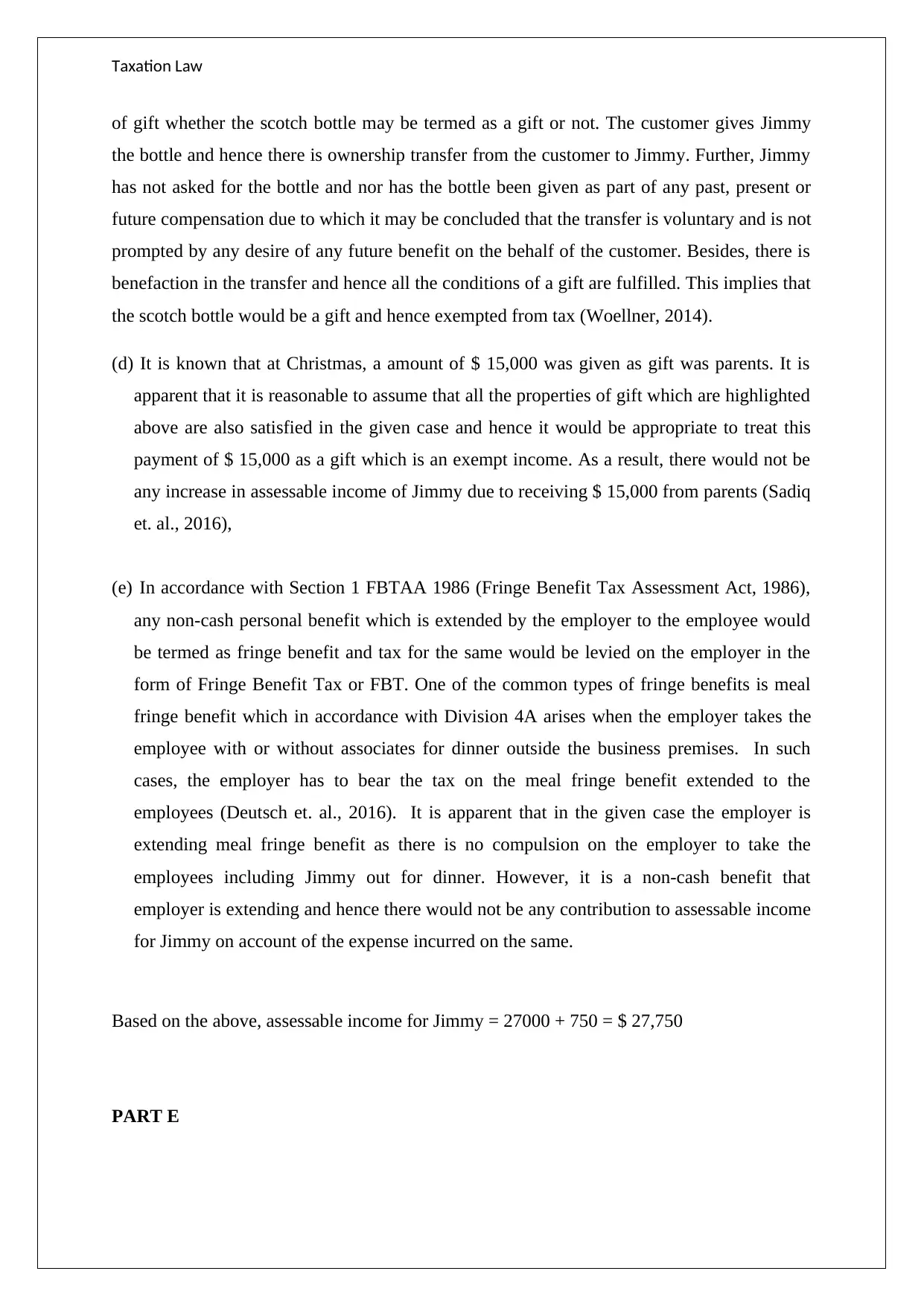
Taxation Law
of gift whether the scotch bottle may be termed as a gift or not. The customer gives Jimmy
the bottle and hence there is ownership transfer from the customer to Jimmy. Further, Jimmy
has not asked for the bottle and nor has the bottle been given as part of any past, present or
future compensation due to which it may be concluded that the transfer is voluntary and is not
prompted by any desire of any future benefit on the behalf of the customer. Besides, there is
benefaction in the transfer and hence all the conditions of a gift are fulfilled. This implies that
the scotch bottle would be a gift and hence exempted from tax (Woellner, 2014).
(d) It is known that at Christmas, a amount of $ 15,000 was given as gift was parents. It is
apparent that it is reasonable to assume that all the properties of gift which are highlighted
above are also satisfied in the given case and hence it would be appropriate to treat this
payment of $ 15,000 as a gift which is an exempt income. As a result, there would not be
any increase in assessable income of Jimmy due to receiving $ 15,000 from parents (Sadiq
et. al., 2016),
(e) In accordance with Section 1 FBTAA 1986 (Fringe Benefit Tax Assessment Act, 1986),
any non-cash personal benefit which is extended by the employer to the employee would
be termed as fringe benefit and tax for the same would be levied on the employer in the
form of Fringe Benefit Tax or FBT. One of the common types of fringe benefits is meal
fringe benefit which in accordance with Division 4A arises when the employer takes the
employee with or without associates for dinner outside the business premises. In such
cases, the employer has to bear the tax on the meal fringe benefit extended to the
employees (Deutsch et. al., 2016). It is apparent that in the given case the employer is
extending meal fringe benefit as there is no compulsion on the employer to take the
employees including Jimmy out for dinner. However, it is a non-cash benefit that
employer is extending and hence there would not be any contribution to assessable income
for Jimmy on account of the expense incurred on the same.
Based on the above, assessable income for Jimmy = 27000 + 750 = $ 27,750
PART E
of gift whether the scotch bottle may be termed as a gift or not. The customer gives Jimmy
the bottle and hence there is ownership transfer from the customer to Jimmy. Further, Jimmy
has not asked for the bottle and nor has the bottle been given as part of any past, present or
future compensation due to which it may be concluded that the transfer is voluntary and is not
prompted by any desire of any future benefit on the behalf of the customer. Besides, there is
benefaction in the transfer and hence all the conditions of a gift are fulfilled. This implies that
the scotch bottle would be a gift and hence exempted from tax (Woellner, 2014).
(d) It is known that at Christmas, a amount of $ 15,000 was given as gift was parents. It is
apparent that it is reasonable to assume that all the properties of gift which are highlighted
above are also satisfied in the given case and hence it would be appropriate to treat this
payment of $ 15,000 as a gift which is an exempt income. As a result, there would not be
any increase in assessable income of Jimmy due to receiving $ 15,000 from parents (Sadiq
et. al., 2016),
(e) In accordance with Section 1 FBTAA 1986 (Fringe Benefit Tax Assessment Act, 1986),
any non-cash personal benefit which is extended by the employer to the employee would
be termed as fringe benefit and tax for the same would be levied on the employer in the
form of Fringe Benefit Tax or FBT. One of the common types of fringe benefits is meal
fringe benefit which in accordance with Division 4A arises when the employer takes the
employee with or without associates for dinner outside the business premises. In such
cases, the employer has to bear the tax on the meal fringe benefit extended to the
employees (Deutsch et. al., 2016). It is apparent that in the given case the employer is
extending meal fringe benefit as there is no compulsion on the employer to take the
employees including Jimmy out for dinner. However, it is a non-cash benefit that
employer is extending and hence there would not be any contribution to assessable income
for Jimmy on account of the expense incurred on the same.
Based on the above, assessable income for Jimmy = 27000 + 750 = $ 27,750
PART E
⊘ This is a preview!⊘
Do you want full access?
Subscribe today to unlock all pages.

Trusted by 1+ million students worldwide
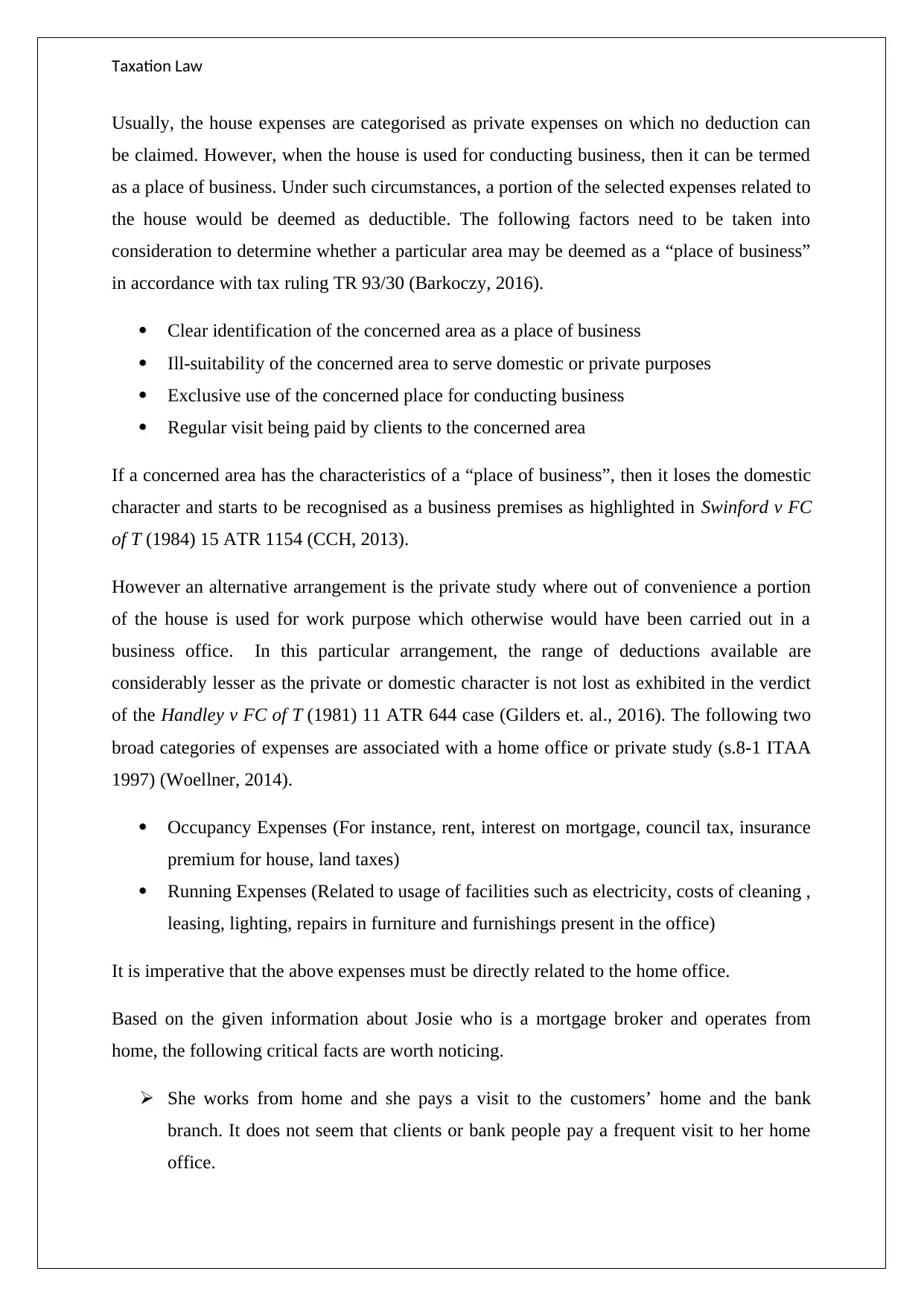
Taxation Law
Usually, the house expenses are categorised as private expenses on which no deduction can
be claimed. However, when the house is used for conducting business, then it can be termed
as a place of business. Under such circumstances, a portion of the selected expenses related to
the house would be deemed as deductible. The following factors need to be taken into
consideration to determine whether a particular area may be deemed as a “place of business”
in accordance with tax ruling TR 93/30 (Barkoczy, 2016).
Clear identification of the concerned area as a place of business
Ill-suitability of the concerned area to serve domestic or private purposes
Exclusive use of the concerned place for conducting business
Regular visit being paid by clients to the concerned area
If a concerned area has the characteristics of a “place of business”, then it loses the domestic
character and starts to be recognised as a business premises as highlighted in Swinford v FC
of T (1984) 15 ATR 1154 (CCH, 2013).
However an alternative arrangement is the private study where out of convenience a portion
of the house is used for work purpose which otherwise would have been carried out in a
business office. In this particular arrangement, the range of deductions available are
considerably lesser as the private or domestic character is not lost as exhibited in the verdict
of the Handley v FC of T (1981) 11 ATR 644 case (Gilders et. al., 2016). The following two
broad categories of expenses are associated with a home office or private study (s.8-1 ITAA
1997) (Woellner, 2014).
Occupancy Expenses (For instance, rent, interest on mortgage, council tax, insurance
premium for house, land taxes)
Running Expenses (Related to usage of facilities such as electricity, costs of cleaning ,
leasing, lighting, repairs in furniture and furnishings present in the office)
It is imperative that the above expenses must be directly related to the home office.
Based on the given information about Josie who is a mortgage broker and operates from
home, the following critical facts are worth noticing.
She works from home and she pays a visit to the customers’ home and the bank
branch. It does not seem that clients or bank people pay a frequent visit to her home
office.
Usually, the house expenses are categorised as private expenses on which no deduction can
be claimed. However, when the house is used for conducting business, then it can be termed
as a place of business. Under such circumstances, a portion of the selected expenses related to
the house would be deemed as deductible. The following factors need to be taken into
consideration to determine whether a particular area may be deemed as a “place of business”
in accordance with tax ruling TR 93/30 (Barkoczy, 2016).
Clear identification of the concerned area as a place of business
Ill-suitability of the concerned area to serve domestic or private purposes
Exclusive use of the concerned place for conducting business
Regular visit being paid by clients to the concerned area
If a concerned area has the characteristics of a “place of business”, then it loses the domestic
character and starts to be recognised as a business premises as highlighted in Swinford v FC
of T (1984) 15 ATR 1154 (CCH, 2013).
However an alternative arrangement is the private study where out of convenience a portion
of the house is used for work purpose which otherwise would have been carried out in a
business office. In this particular arrangement, the range of deductions available are
considerably lesser as the private or domestic character is not lost as exhibited in the verdict
of the Handley v FC of T (1981) 11 ATR 644 case (Gilders et. al., 2016). The following two
broad categories of expenses are associated with a home office or private study (s.8-1 ITAA
1997) (Woellner, 2014).
Occupancy Expenses (For instance, rent, interest on mortgage, council tax, insurance
premium for house, land taxes)
Running Expenses (Related to usage of facilities such as electricity, costs of cleaning ,
leasing, lighting, repairs in furniture and furnishings present in the office)
It is imperative that the above expenses must be directly related to the home office.
Based on the given information about Josie who is a mortgage broker and operates from
home, the following critical facts are worth noticing.
She works from home and she pays a visit to the customers’ home and the bank
branch. It does not seem that clients or bank people pay a frequent visit to her home
office.
Paraphrase This Document
Need a fresh take? Get an instant paraphrase of this document with our AI Paraphraser
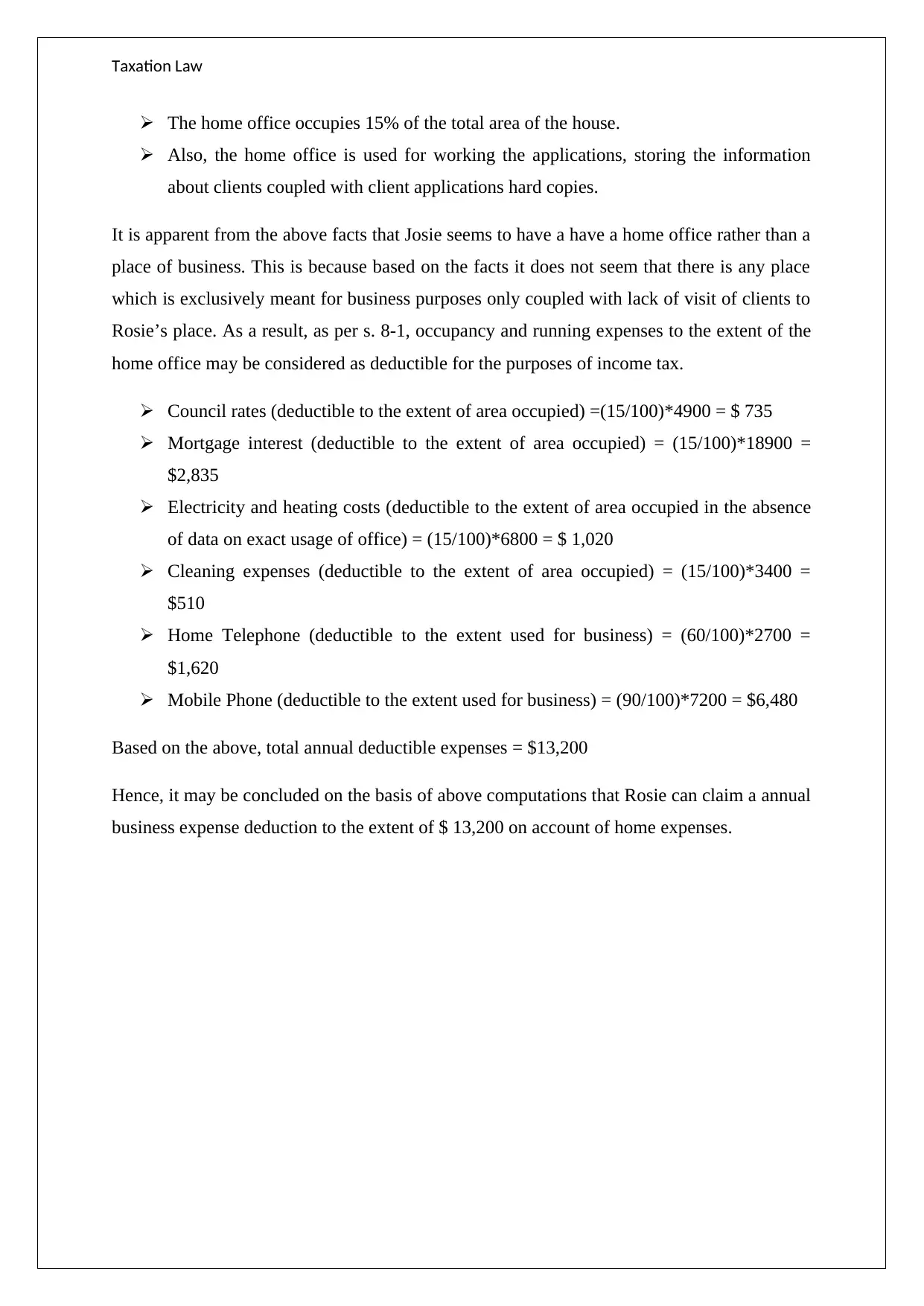
Taxation Law
The home office occupies 15% of the total area of the house.
Also, the home office is used for working the applications, storing the information
about clients coupled with client applications hard copies.
It is apparent from the above facts that Josie seems to have a have a home office rather than a
place of business. This is because based on the facts it does not seem that there is any place
which is exclusively meant for business purposes only coupled with lack of visit of clients to
Rosie’s place. As a result, as per s. 8-1, occupancy and running expenses to the extent of the
home office may be considered as deductible for the purposes of income tax.
Council rates (deductible to the extent of area occupied) =(15/100)*4900 = $ 735
Mortgage interest (deductible to the extent of area occupied) = (15/100)*18900 =
$2,835
Electricity and heating costs (deductible to the extent of area occupied in the absence
of data on exact usage of office) = (15/100)*6800 = $ 1,020
Cleaning expenses (deductible to the extent of area occupied) = (15/100)*3400 =
$510
Home Telephone (deductible to the extent used for business) = (60/100)*2700 =
$1,620
Mobile Phone (deductible to the extent used for business) = (90/100)*7200 = $6,480
Based on the above, total annual deductible expenses = $13,200
Hence, it may be concluded on the basis of above computations that Rosie can claim a annual
business expense deduction to the extent of $ 13,200 on account of home expenses.
The home office occupies 15% of the total area of the house.
Also, the home office is used for working the applications, storing the information
about clients coupled with client applications hard copies.
It is apparent from the above facts that Josie seems to have a have a home office rather than a
place of business. This is because based on the facts it does not seem that there is any place
which is exclusively meant for business purposes only coupled with lack of visit of clients to
Rosie’s place. As a result, as per s. 8-1, occupancy and running expenses to the extent of the
home office may be considered as deductible for the purposes of income tax.
Council rates (deductible to the extent of area occupied) =(15/100)*4900 = $ 735
Mortgage interest (deductible to the extent of area occupied) = (15/100)*18900 =
$2,835
Electricity and heating costs (deductible to the extent of area occupied in the absence
of data on exact usage of office) = (15/100)*6800 = $ 1,020
Cleaning expenses (deductible to the extent of area occupied) = (15/100)*3400 =
$510
Home Telephone (deductible to the extent used for business) = (60/100)*2700 =
$1,620
Mobile Phone (deductible to the extent used for business) = (90/100)*7200 = $6,480
Based on the above, total annual deductible expenses = $13,200
Hence, it may be concluded on the basis of above computations that Rosie can claim a annual
business expense deduction to the extent of $ 13,200 on account of home expenses.
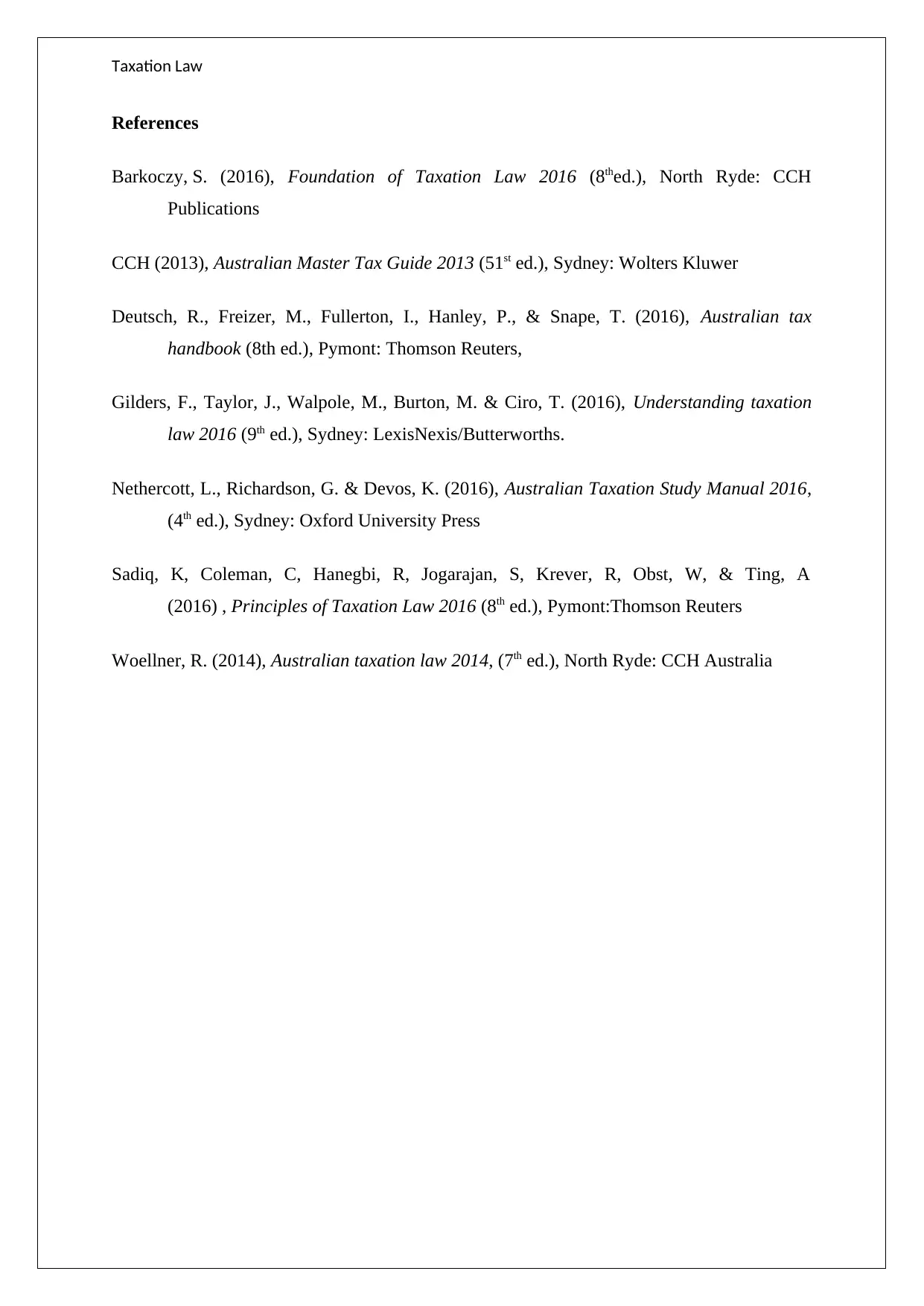
Taxation Law
References
Barkoczy, S. (2016), Foundation of Taxation Law 2016 (8thed.), North Ryde: CCH
Publications
CCH (2013), Australian Master Tax Guide 2013 (51st ed.), Sydney: Wolters Kluwer
Deutsch, R., Freizer, M., Fullerton, I., Hanley, P., & Snape, T. (2016), Australian tax
handbook (8th ed.), Pymont: Thomson Reuters,
Gilders, F., Taylor, J., Walpole, M., Burton, M. & Ciro, T. (2016), Understanding taxation
law 2016 (9th ed.), Sydney: LexisNexis/Butterworths.
Nethercott, L., Richardson, G. & Devos, K. (2016), Australian Taxation Study Manual 2016,
(4th ed.), Sydney: Oxford University Press
Sadiq, K, Coleman, C, Hanegbi, R, Jogarajan, S, Krever, R, Obst, W, & Ting, A
(2016) , Principles of Taxation Law 2016 (8th ed.), Pymont:Thomson Reuters
Woellner, R. (2014), Australian taxation law 2014, (7th ed.), North Ryde: CCH Australia
References
Barkoczy, S. (2016), Foundation of Taxation Law 2016 (8thed.), North Ryde: CCH
Publications
CCH (2013), Australian Master Tax Guide 2013 (51st ed.), Sydney: Wolters Kluwer
Deutsch, R., Freizer, M., Fullerton, I., Hanley, P., & Snape, T. (2016), Australian tax
handbook (8th ed.), Pymont: Thomson Reuters,
Gilders, F., Taylor, J., Walpole, M., Burton, M. & Ciro, T. (2016), Understanding taxation
law 2016 (9th ed.), Sydney: LexisNexis/Butterworths.
Nethercott, L., Richardson, G. & Devos, K. (2016), Australian Taxation Study Manual 2016,
(4th ed.), Sydney: Oxford University Press
Sadiq, K, Coleman, C, Hanegbi, R, Jogarajan, S, Krever, R, Obst, W, & Ting, A
(2016) , Principles of Taxation Law 2016 (8th ed.), Pymont:Thomson Reuters
Woellner, R. (2014), Australian taxation law 2014, (7th ed.), North Ryde: CCH Australia
⊘ This is a preview!⊘
Do you want full access?
Subscribe today to unlock all pages.

Trusted by 1+ million students worldwide
1 out of 9
Related Documents
Your All-in-One AI-Powered Toolkit for Academic Success.
+13062052269
info@desklib.com
Available 24*7 on WhatsApp / Email
![[object Object]](/_next/static/media/star-bottom.7253800d.svg)
Unlock your academic potential
Copyright © 2020–2025 A2Z Services. All Rights Reserved. Developed and managed by ZUCOL.





